
The Life and Times of Hubert Brooks M.C. C.D.
A Canadian Hero

 |
|
 |

| |
|
Upon returning to Scotland, my good friend John Duncan was married and found happiness (see PHOTO at right -- his war time nickname was "Curly" and mine was "Butch").
I was able to visit him in Scotland when
I was again in Europe with the MRES.
Thereafter I stayed in contact with him with yearly Xmas cards and notes.
I was never able to return to the scenes of my partisan day in southern Poland but I was able to help some of my A.K. comrades–in–arms find a safe home in Canada.
I was always careful not to reveal the location of my partisan friends in Canada as the Polish communist government and their agents were constantly looking for leverage with relatives back home. Later, with time, various Polish publications celebrating the exploits of these heroes published the general locations as to where these partsians lived.

Here are the names of the partisans who fought in the Podhale Region of the Carpathian Mountains and who resided in Canada just after the war: (as originally published in the "Polish Bulletin" Calgary and re–printed in the Polonia Voice article "CANADIAN HERO IN POLAND : STORY OF HUBERT BROOKS, Wing Commander." Refs: 1.3 &1.4 & 1.5 )
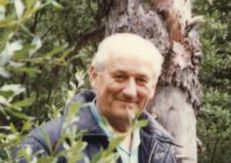
|
Yet another of the Podpolesk partisans Tadek Kiedron "Piorun" went to Hamilton (actually Stoney Creek) but I lost contact with him over time. There are others in the United Kingdom and in the US.
Major Borowy and his three brothers, who were among the original 40 partisans at the time I joined the A.K., immigrated to Canada.

|
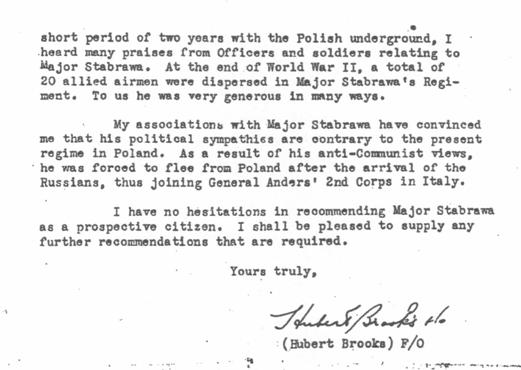
|
Lt. Col. Adam Stabrawa aka "Borowy" or "Boric" – Knight Virtuti
Military Cross – died on 22 April 1991 in Vancouver, Canada. Most of his time in Canada was spent in central British Columbia (town of Mission) running
a mink farm. His ashes were buried in his native Polish soil, in the family tomb – in the local cemetery in Myślenice.
I was proud to call him my friend.
After giving the order on January 19, 1945 to demobilize his soldiers in the 1 PSP AK, Major Stabrawa, like all of the AL leadership, was threatened with arrest. He went to Krakow to lie low with friends
(including briefly staying at the Augustinian monastery). While in Krakow and till July 1945, he continued to ensure the demobilization of his Nowosądeckie Inspectorate.
On August 30, 1945, along with a group of fellow AK officers, Adam surreptitiously crossed the border into Italy where he joined the 7 Pułk Artylerii Konnej (7 pak) (7th Regiment Horse Artillery) within the 2 Korpus Polski (2 KP) (2nd Corps) under
General Władysław Anders. He stayed with this unit until its demobilization on January 31, 1949, at which point Adam moved to the UK. Shortly thereafter I sponsored Adam's move to Canada.
|
Two brothers who operated in my platoon were among the original 40 partisans at the time I joined the AK moved
to Alberta. They were "Iglica" and "Szczerbina".
Zygmunt Mankowski ps "Iglica", I happened to meet on the streets of London in 1948 when I was on my way
to the winter Olympics. We went into a bar to have a celebratory drink, and I told him he had to come to Canada. He had previously applied to come to Canada from Italy but had been turned down
as Canada was looking for laborers not officers. The British had told him they could get him into Australia.
Next day we went into the Canadian embassy and I was able to help expedite his entry. Two days later he
was on a ship heading for Canada! I'd told him to move to Alberta where the jobs were plentifull, and sure enough, day after he arrived he was able to secure a job!.
His brother Wojciech Mankowski "Szczerbina" followed in 1956 coming from
Holland (In Canada Wojciech went by the first name "Albert"). After marrying a German girl in Canada they moved back to Germany where Wojciech worked till retirement. The couple then moved back to Poland where
Wojciech passed away at the age of 90 circa 1997.
|
After disassembly in January 1945, Józef Węglarz (ps "Mały") managed to avoid arrest 3 times. The first time the NKVD came to his family home to arrest him but did not find him as he was studying in Krakow Jagiellonian University at the time. Instead they arrested his father Ludwik who was sent to an internment camp in Bulasz east of the Ural Mountains where he died of a heart atack on Oct 26, 1945. The second time Józef was astute enough to notice 3 men watching his Krakow apartment front door and was able to avoid arrest. The third time the local police (officially called the Citizens' Militia) had Józef and his brother Janek in their hands at the Mszana Gorna train station, but luckily, they were not exactly sure who they had. As the police tried to sort things out by calling the local Office of Security, Józef managed to escape out of a washroom and once again evade capture. Unfortunately Janek was detained and interrogated -- but managed to talk his way out of the situation.
Józef then hid with the Magierski family from Zakret from early 1945 until the summer of 1946 when he left Poland. He joined Jan Stachura, his wife Kazimiera Sobieski, Karol Mierzwa "Wicher"
and some others who, via an
army-like truck made their way to Cieszyn and the Czechoslovakian border. They crossed the border in Marklowice and continued to a train station in Petrovice where they boarded a train dedicated to the
French Red Cross (the train had been set up by Cpt. Stefan Rybicki - a former
officer of the French Foreign Legion who was in charge of this cross-border repatriation channel between Poland and the West). The French Red Cross train brought them from Czechoslovakia to a transit camp in
Nuremberg Germany.
(Historical Note: The Stachura-Węglarz et al exodus from Poland on the French Red Cross train
was the last transport through this channel, as one of their fellow escapees was a mole, an agent of the Office of Security (UB) who informed on the escape route -- leading to the capture of Cpt Rybicki and a group of partisan escapees on the next transport on Oct 5, 1946.)
From Nuremburg the group arrived safely in Meppen at the Dutch border in the British Sector where General S. Maczek with his Polish Armored Division was stationed. Józef was assigned to a former prisoner-of-war camp in Oberlagen where he took command of a platoon in the rank of 2nd Lieutenant.
From April 1947 to October 1948 Józef served as an officer asa Junior Superintendent of Civil Mixed Watchman Service at RAF airfields in Luneberg, Flensberg, Husum and Fassberg.
While in Germany, Józef aranged through an uncle Józef Węglarz living in Chicago a permanent visa to Canada to work on a farm in Ridgetown Ontario that his uncle had bought. Jozef agreed to work on the farm for at least a year to pay back the cost of the trans Atlantic voyage.
After the year on the farm, Józef moved to Windsor Ontario where he worked at a variety of jobs finally ending up as a Department Manager for Chrysler.
Józef retired from Chrysler late February 1988 and moved from Windsor to the picturesque town of Peterborough Ontario where he was very active with the local Polish community and the local Branch 15 of the Polish Combatants Association (SPK).
|
Józef Węglarz (ps "Mały") passed away April 24, 2008.

|
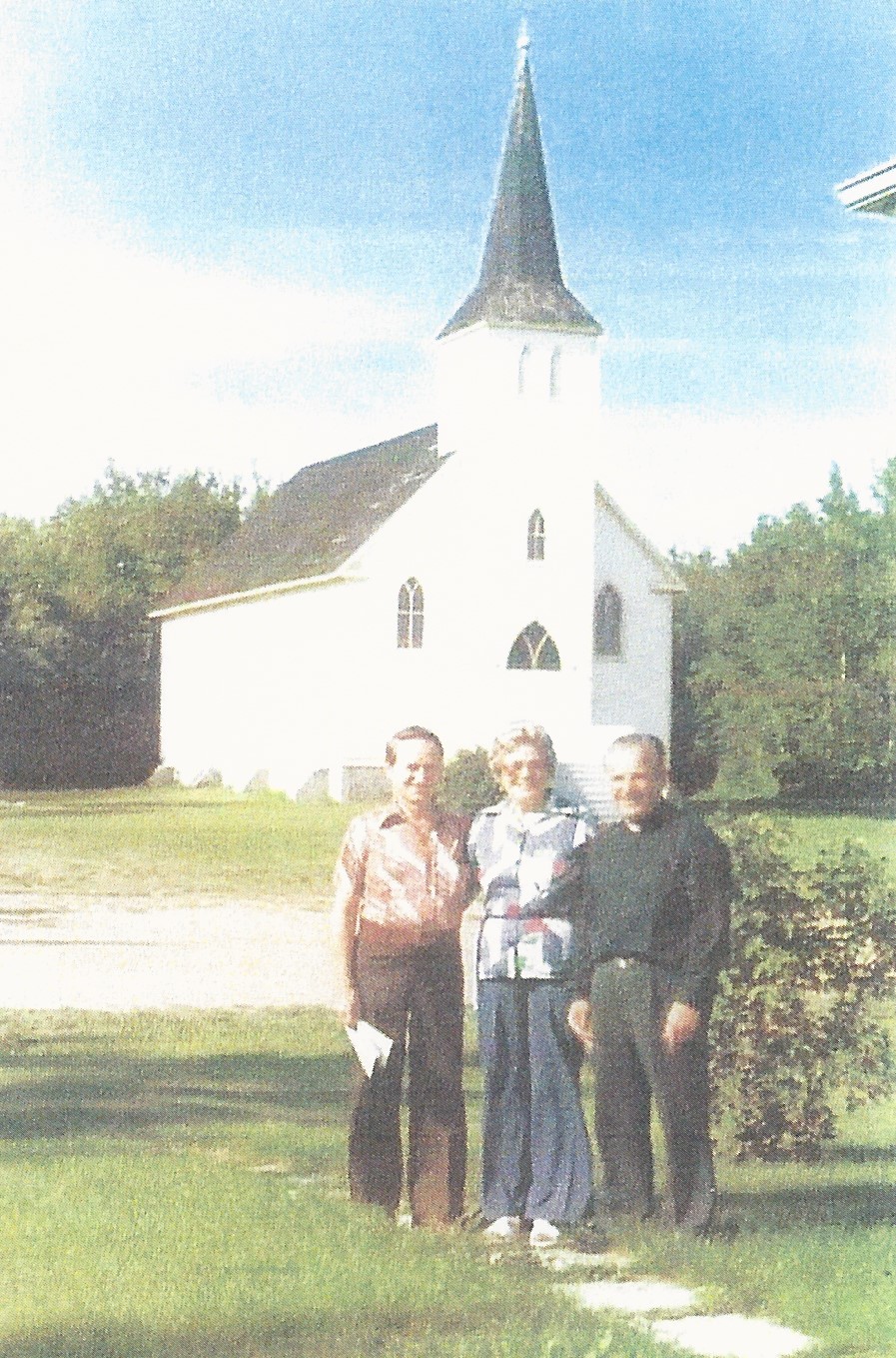
|
My dear friend Second Lieutenant Monsignor (Ksiądz Prałat) Józef Kochan "Krzysztof" spent a number of years in the Edmonton Alberta area before returning home to his native Poland.
On June 13, 1982; St. Paul Cathedral Parish announced Clergy Appointments one of which was for Monsignor Joseph Kochan to be the parish priest for the towns of Vilna and Smoky Lake - both located off of Highway 28 just north east of Edmonton Alberta.
Page 65 of the 2008 Memoirs of Józef Węglarz has the following paragraphs:
"To supplement my memoirs I asked the Prelate Father Józef Kochan "Krzysztof", the Chaplain of section "Mszyca" during the war, to recall his most memorable
wartime moments.
In a letter from March of 2003 he wrote:
"I was very close to Adam (Jan Stachura) - some joked that I was his Gardian Angel.
It was Christmas Eve 1943 and at 8 PM we had the shepherds mass for the soldiers in the school in Letowe.
After the mass we walked to Lipowka with an invitation to a supper with the Zapala family.
There was four of us; "Adam", Hubert Brooks - a Canadian flyer, John Duncan - a British flyer, and I.
(Editor's Note: John Duncan was a British soldier not a flyer)
Suddenly on the road from Mszana Dolna to Lubomierz we saw headlights of an incoming car.
We jumped into the ditch (there was no snow) for we knew it was the Germans; the Poles weren't allowed to drive or own cars.
"Adam" said: "Nobody shoots until I take a shot".
Somehow the passing car was lit inside and we saw three German soldiers including an officer.
We could shoot them but with tension we awaited the signal - nothing but silence.
They drove by and we got out of the ditch and continued our march for the next half-hour.
After our hosts greeted us we were preparing for the supper.
The mood was joyful and loose when the Canadian hugged "Adam", kissed him and said
"Now I understand why we did not shoot the Germans".
"Adam" replied,
"On a day like today I would not shoot even a German or my worst enemy".
"Adam" was my friend. He was religious, he loved his soldiers, and he would never expose them to unnecessary dangers for his own gain or glory. He would never endanger the civilian population to a German retaliation.
For that the locals of Mszana, Rabka, Nowy Targ and surroundings respected and loved him back".
Digital copies of documents attesting to the war time service of ks. Józef Kochan with the 1 Pułk Strzelców Podhalańskich (1 PSP AK) and the group "Adam" can be viewed by
clicking on the following links :
Kwestjonarjusz Specjalny
and also
OSWIADCZENIE posiadania słopnia - lub - odznaczenia.
|
Monsignor (Ksiądz Prałat) Józef Kochan "Krzysztof" passed away August 17, 2004 and was laid to rest in Myslenice Poland.

|
My friend Abbot Hubert Franciszek Kostrzański "Mirt" died in Chicago on January 5th 2002
at the age of 83.
|
|
Jan Stachura "Adam" was arrested by the NKVD just after the section disassembly in January 1945. He was prominently on the list drawn up by the NKVD's Ivan Zolotar.
In prison in Wadowice, and destined to be sent to Siberia, Adam orchestrated a prison break with a number of other partisan prisoners. In escaping they avoided what was then called "The Polar Bear Excursion" (to Siberia).
Adam then hid around Mszana until the fall of 1945 when an amnesty for all members of the Home Army (AK) was declared.
Adam managed to escape to France (see Józef Węglarz story above for details) where he settled and ran a farm. He had three children: son Mark (Marka) and daughter Margaret (Małgorzatę) and Hedwig (Jadwigę).
|
Jan Stachura died in 1985 in the town of Villiers-le-Morhier, France and was buried there.
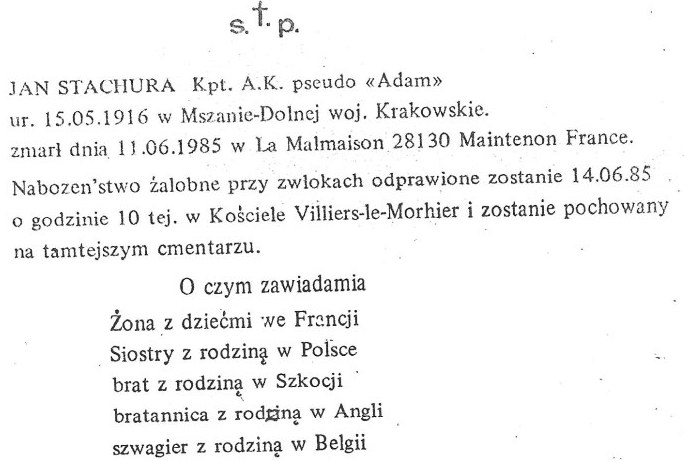
|
|
The Biography of Julian Krzewicki as released by his son Dr. Jerzy Krzewicki in 1996 details the troubling times that this Polish Hero who decided to remain behind in his beloved country
had under Soviet backed rule.
Unfortunately this sort of treatment was the norm for a great number of the members of the war time AK. This included a number of my close friends such as Julian.
From the Biography:

|
|
Julian Krzewicki maintained his command of 2nd Battalion 1 psp AK and Head of Limanowa Region until January 16, 1945, then hid until October 1, 1945 before coming out into the open.
In early January 1948, he was arrested by the secret police in Gorlice. Reason for the arrest was allegedly distribution of an anti-communist leaflet.
Julian Krzewicki was released after a few weeks in mid February 1948.

|
Feb 7, 1950 Julian Krzewicki was arrested again and sent to Gorlice PUBP prison - leaving behind a wife and 2 young children without means of support.
For 14 days and nights he was constantly tortured. The interrogators wanted him to admit to the allegations: belonging to WiN, cooperation with Germany, the killing of Jews and Soviet prisoners and hiding weapons
and ammunition from three air drops.
A steady rotating round of interviewers aka torturers ensured that Julian was without sleep and almost entirely without food. Often times several torturers beat him at the same time. They beat him in the face,
kicked him in the kidneys and so forth. Despite having swollen legs, feet covered with blisters, difficulty breathing because of chest pain, they continued interrogating him for several days and nights without
allowing him any sleep.
Those responsible for the torture included: Head PUBP Bronisław Kruczek, investigator Edward Zygler, Bronisław Jagiełło and many others.
After 14 days of such torture Julian had hallucinations and impaired consciousness. Some 3 days later, the prison doctor, Dr. Zdzislaw Pyszyński took him in, cut the blisters from his feet,
made dressings for his wounds and ordered medications.
After three months of detention in Gorlice May 18, 1950 he was transported by rail to WUBP in Krakow - where the same allegations were made as in Gorlice.
The investigation started from the beginning with the same methods, sometimes adding pulling out of handfuls of hair, spitting in the face, and knocking out teeth.
Julian Krzewicki was released from detention due to lack of guilt on April 29, 1951. He and his family continued to be harassed by police - losing jobs as well as his family apartment.
By 1956 the harassment stopped and he found a job at the Gorlice Food Wholesale Market - retiring as head of sales.
Julian Krzewicki ("Filip"), commander of 2nd Battalion 1 psp AK and Head of Limanowa Region, Polish Hero, died on 11th August 1987 in Gorlice. In 1988 Gorlice was to honor its home town hero by naming a street after him.
Julian's wonderful wife Barabra (Stormke) Krzewicki ("Wieslawa") passed away in 2003.
On a negative note, subsequent to the war "Ogień" Józef Kuraś remained a very controversial figure. Immediately after the war Kuraś was an officer of the secret communist police (PUBP) in Nowy Targ. However Kuraś quickly fell out of favor with the communists and once again went into the mountains to hide and fight - this time against the communists. In the fall of 1946 the communist authorities began a major offensive against Kuraś' partisans. On January 21, 1947, finding himseld surrounded Kuraś gave his second wife Hanka an order to surrender herself and after she did so, shot himself in the head. He did not die immediately and as a result was taken, unconscious to the hospital in Nowy Targ where he died the following day.
Since his death, some of the people associated with him during the war have tried to now portray him as a "hero". Perhaps remarkedly, perhaps under the thought process of the "enemy of my enemy is my friend" school of logic, Kuraś was officially rehabilitated in 2006 (after the fall of communism in Europe) when the Polish President Kaczynski opened an official memorial in Zakopane, "in recognition of his resistance efforts".
In my opinion and that of most AK officers, and a number of historians and witnesses - he was just a thug.
In particular, the Slovaks and the inhabitants of the Podhale region have protested against this "hero" categorization because many people from these regions were murdered by him for no reason both during the war and immediately after when Kuraś co-operated with the communists. The Slovaks living on both sides of the border were incensed and could not understand why a man (Kuraś) who;
was somehow now suggested to be a national hero -- not only grossly falsifying history but adding insult to injury proposing that both a statue be erected and that a street be named after Kuraś.
Finally Private Frederick Selwyn Cole, the Kiwi who had exchanged identies with me back at Stalag VIII B (E478) in the May 1942 timeframe, stayed a P.O.W. for the duration of the war at
STALAG VIII B -later named Stalag 344.
Unfortunately while a P.O.W., Fred contracted a severe case of pulmonary tuburculosis. This was so severe that when he eventually got back to New Zealand he was judged to be 100%
disabled.
Cole arrived back in the U.K. on April 24, 1945 and then arrived home in New Zealand on the hospital ship ORANJE August 10, 1945.
Private Frederick Cole was awarded the 1939-45 Star, the Africa Star, the War Medal 1939-45, and the New Zealand War Services Medal.
Cole who had enlisted on October 3, 1939 was released from the military on November 14, 1946.
He married Meg Florence Cole and the couple lived and retired in Whangarei, NZ (just north west of Aukland on the north island).
Some PHOTOS of the B17G American eveaders back at their home base in Italy right after the war.
|
|
With regard to the B24J Liberator "CALIFORNIA ROCKET" story, the ever-grateful Poles would errect a monument at the mountain forest site (geographical co-ordinates 49� 32' 21.09" N 20� 10' 33.77" E) in the Gorczański Park Narodowy where the plane crashed.

The town of Szczawa, located at an altitude of 900 m above sea level, is now a holiday village in the municipality of Kamienica, in the county Limanowa, between the slopes of the Gorce and Beskid Wyspowy. This area was where Maj. Adam Stabrawa "Borowy" brought together a large number of independant guerilla groups under the 1 PSP AK banner.
In present day, every year on the first Saturday and Sunday after August 15, veterans and citizens meet in the center of the village at a museum constructed to honor the 1 PSP AK to honor the heroic struggle for independance.
The 1 PSP Army Museum in Szczawa contains numerous relics from the period of World War II in the form of posters, uniforms, letters, photographs and so forth --
all commemorating actions by the 1 PSP Army.
(Editor's Note: There is at least one picture including Hubert Brooks - see below- which I am trying to get a better copy of.)

|

|
| |

|
In Szczawa there is a monument dedicated to the 1 PSP AK.

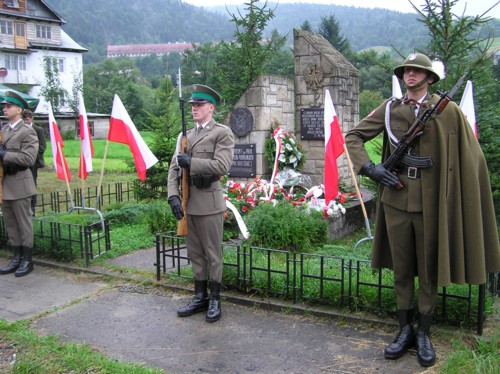
Finally, also in Szczawa on the first Sunday after August 15, next to the old wooden church dedicated to the partisan guerillas. on the right side of the church altar there is a plaque commemorating 1 PSP AK, and in the bell tower there are two plaques depicting the history of 1 PSP AK. (The construction of the "Church of the Partisan" was started in 1958 and completed in 1960. )
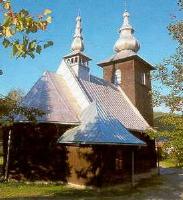



|
Below is a rough English translation of Dawid Golik's 2014 article
"Jubelt" i "John" - alianci w podhalanskiei AK Ref: 3.43
By Dawid Golik
" Jubelt " and " John" - Allies in the Polish Underground Highland Army
They met in the fall of 1942 in Stalag VIII B Lamsdorf , located in the area between Nisa and Opole Łambinowice.
Hubert Brooks was a Canadian aviation warrant officer, John Duncan sergeant elite Scottish infantry regiment. Merged their friendship , courage and bravado , and joint service in the Army.
Sgt. John "Curly" Duncan was a Scot and has served since 1928 as a professional soldier in the elite British regiment of Gordon Highlanders in Africa and India , and after World War II, he was sent as part of the British expeditionary force to France. During the fighting at Dunkirk in June 1940, he was captured by the Germans, which before meeting with Brooks twice fled . The first flight was a success and for over a year Duncan hiding in France. Went back to the camp because of a betrayal from a jealous women who had been hiding him. Another attempt to break out of captivity was not so happy.
In turn, ensign Hubert Brooks was a volunteer for service in the Canadian Air Force and was assigned to the 419th Bomber Squadron. On the night of 8 to 9 April 1942, the aircraft, for which he was a navigator, was shot down over German Oldenburgiem . He was taken prisoner and then exchanging identity documents with a New Zealander army private, was sent to Stalag VIII B , which Brooks twice undertook an attempt to escape.
Partisans " Wilk"
In September 1942, John and Hubert were in subordinate labor camp Stalag Toszku in Gliwice, where they were employed under the guard of Germans in the local sawmill. Quickly came to the conclusion that they should perform another escape together. They began meticulous preparations - stockpiling food, acquiring maps, looking for contacts with the Polish underground. From a German woman they managed to even get a small compass. They knew that they would not already have another chance, and that if this time they will not succeed, they would be sent to the prison camp (as opposed to a work camp), from which escape would be impossible. Therefore, they were patient , they did not hurry their escape and waited for an opportune moment.
There plan was realized after eight months, May 10, 1943, shortly before midnight, [ ... ] they crossed the woods and we disappeared into the night.
They traveled at night and slept in the woods during the day - Brooks recalled.
With the background informational help help of one of the local Poles in their prison workcamp, they managed to escape from the territories of the Reich to the Polish Underground General Government.
There, AK channels they were re-directed to several groups in Czestochowa.
The Local Underground Army took care of them for the next half a year, but due to the approaching winter decided to pass them them up and insert them in one of the operating partisan groups. Thus, in November 1943, Brooks and Duncan were in Podhale and the AK Nowy Targ guerrilla group sent them to the Red Circle camp in the Gorce Mountains.
Thw Canadian's first visit to the branch of "Wilk" was remembered as follows: "It was October [ possibly November ] , and on the tops of the Carpathians was already snow when we finally got
to the shelter of our partisan camp. It was a coarse shelter built in the mountainside and when we arrived, most of the 40 fighters AK were sitting and eating dinner. Our eyes opened widely as to what was before us on our plates.
There had to be on them at least two pounds of beef. After our poor diet, black bread and German rations, it was an incredible treat.
"We can not live like this and live," Brooks said.
"You will soon get tired of the meat ," replied the guerrillas; , and it turned out to be true, that we ate meat at every meal, beef, venison and pork.
Soon, the two allied soldiers become an important part of the branch also given them nicknames that were derived from their names - " Mr. John" (but more often simply " John" ) and "Jubelt" for Brooks.
Brooks relatively quickly learned the Polish language, also remembered him as a sympathetic and sincere man. Duncan to end the war had language problems, but captures all the personality and incredible knowledge of the military . He was also an excellent shooter, which often evident during the various fire fights.
The baptism of fire (battle) for the Allies passed in February 1944, when by order of the commander of "Wilk" , por. Krystyna Więckowskiego "Zawisza" , took part in the police break
up the "police garrison - granatowey" in the Ochotnicy Dolnej. Although the attack force ended up getting the building and the stored arms and ammunition (with the loss of one guerrilla), the retreating
skiing partisans caused a German raid to be launched on the camp.
At dawn on February 21, 1944 there arrived at the Szczawnica estate Przysłop, where in one of the houses rested worn out by a long march in the guerrillas.
Almost immediately ensuing chaotic struggle in which five underground soldiers were killed and the rest had to flee to a nearby forest.
The Allied soldiers stood out especially Duncan. As reported by one of the Home Army guerillas;
"An outstanding presence of mind and cool then showed particularly John [...]."
First stoically finished the aforementioned [ Gestapo ] Maiwald , then fleeing into the woods managed to get out of hand MG 42 [ killed ] Kruka and Slawek.
Podhalańczycy AK
After the German attack on Przysłopie, the branch "Wilk" had to temporarily restrict their activities and by the spring of 1944, again became active fighting against the Nazis. By this time both Brooks and Duncan permanently ensconced in the ranks of the Highland Army. Formally, they were soldiers "Zawisza" , but often also performed tasks assigned to them by the officers of the inspectorate AK Nowy Sacz. They became friends with numerous highland families from the area Zbludzy, Kamienicy and Szczawa.
In August 1944, after the launching of the "Burza", both received the assignment to a the partisan group
Limanowej OP AK "Topór ". Deputy Commander of the branch, see Jerzy Wisniewski " Sochacki" he wrote about John:
" It is difficult to determine whether John was more comical and more courageous. Both of these features make his character unique. [ ... ]
Today, I can still see the laughing mouth, glistening in the sun copper hair and John's captured dog Dux striding majestically besides his master. [ ... ]
The dog, dressed by John in a German helmet and captured cross from the Eastern Front - the so-called Winterschlacht, Dux accepted his parade.
Cheerful, courageous, with an artificial jaw , as his own teeth had been lost before the war, during some fights - the Polish correctly only used a few curses and the names of the girls who pronounced correctly .
We all remember how often John would disappear for a few days, and his "den" of female names , " Hanusia ", " Marysia " , etc.
Courage , however, was the dominant feature of Scots - ascertained " Sochacki " - he loved the fight , during which time dimmed his dream of girls.
"Jubelt " was , in turn, more introverted , secretive, although at the very end of the war could speak Polish well. Not given to emotions, he was meticulous in performing the tasks , what endeared himself especially respect for officers. He was also at the very end of the war a man trusted by the commander of the 1st Podhale Rifles Regiment Army , Major Adam Stabrawa " Borowy " who used Hubert, inter alia, for contacts with others while Borowy stayed in the safety regiment hideouts.
One day, Hubert had to check on the conditions in which some sheltered allied airmen lived and if they have any expectations of the Home Army.
After returning to headquarters he reported :
" When I walked into the hut , the airmen sat on the floor around a large clay pot. One of them was kneading grated potatoes for a potluck with dozens of eggs, another soaked his feet in the kit after which wiped them
with a cloth, wrapped the leg with silk maps of airports and put on shoes. I said hello and asked how they were doing ?
" Fucken Europe , fucken Hitler, fucken Poland " - was the answer.
Very concerned about the attitude of the airmen " Borowy " suggested Brooks assume personal responsibility for them and gradually explain to them what the life of a partisan was like. Brooks definitely refused.
He stressed he did not want to be their nanny and will remain at headquarters, with the Poles.
During subsequent inspections of the downed pilots Maj. Stabrawa reminded them they uttered the word " Fucken Poland " and stated that if they do not like hospitality of the Polish partisans,
he could send them a guide who would lead them to the camp of one of the quartered nearby Soviet branches.
Problems persisted with the Allied airmen and command 1 psp AK right to end the war.
Deputy Capt. Vladimir Budarkiewicz " Podkowa" wrote "Borowy" : Near the accommodation of the allied airmen was hiding the Volksdeutscher Freytag , the son of the owner of the stores " Nur für Deutsche " in Zakopane. [ ... ]
The American airmen caught up with him and killed him, they took off his finger a gold ring with a diamond. Pocket money brought on their combat flight had been used up, the ring could buy food and eggs for the next potluck.
No wonder with this sort of activity, John and Hubert did not want to have a lot in common with them , or to do with them.
Soviet " Assistance "
By the end of the war " John" and " Jubelt " were used for different actions.
They participated in liquidation of informers, attacking German gendarmerie stations, and during the " Burza " took part in battles
against the Germans during the attack on the railway station in Kasininie Wielkiej and clashes in the area Wisniowa and Gruszowca .
After the formation of the first Podhale Rifles AK ( 1 PSP AK) they were staying temporarily at the command of the regiment, and at the
Headquarters of the AK Limanowa.
Duncan often dressed in civilian clothes , with short arms, carried messages, and as he used to say he would go " bask " for the
friendly hosts . One day, along with Sec. Louis Schweiger " Siwym " came home cooperating with the Army doctors .
He wrote about Capt. " Podkowa " :
Before the house for an upcoming profile , became a German soldier with a rifle. At the last moment John realized the danger,
took a few steps back and whispered to " Siwym " - " German, shoot , shoot " .
"Siwym" instantly drew a pistol and fired several shots into a German soldier who groaned and fell to the ground.
The partisans turned around to the back of the house and began to run , for a moment they were showered with shots.
Everyone came out of the adventure unscathed , only the " Siwym " lost his backpack thrown from his shoulders to facilitate the run ,
ahead of the dog " Dux " .
In turn, Hubert in the last weeks of the war was given the task of finding an appropriate landing site , which before the front specially sent a plane could take to Italy gathered at the regiment Americans and the British. Such a place was found and the exact coordinates were sent by radio to the Allies . The plane , however, never came and we all had together to wait for the arrival of the Red Army , however, not expecting anything good from their side .
January 19, 1945 have been desolved the ranks of 1 psp AK and all the soldiers of this unit were sent home.
Brooks and Duncan in the company of another pilot waited in the mountains for the passage of the first wave of Soviet troops, and then decided to march towards Warsaw . Soon, however, they were stopped by a patrol of the NKVD , who transported them to Myślenice first and then to the front line in the area of Bielsko. They did not admit to the fact that they were soldiers of the Home Army - knowing what it threatens, instead stating that it was only a few weeks ago that they escaped from German captivity . From the Bielsko they moved them to bulk camp in Nowy Sacz , where they met other foreigners known to them from the Highland Army. Finally after some time, they were transported to the east to Lviv , Kiev, Odessa , Port Said and Cairo, arrived in the spring of 1945 in London.
There the road of the two friends finally parted - Hubert returned to Canada , and John went to his native Scotland .
Over the years they wrote to each other, sent cards for the holidays. Never again , however, have they visited Poland and the Highlands. (A price persisted on Brooks' head for time by the Soviets.)
Despite this, the memory of the original duo , sometimes called " Siamese brothers," has survived to this day in the memories of their colleagues from AK and Beskid Highlanders.
75th Anniversary of Warsaw Uprising and War Against Nazis
For the commemeration of the 75th anniversary, a T shirt was produced to distribute as a give-away to participants. The T shirt shown below (with front and back sides) featured Hubert Brooks (with machine gun over one shoulder, and hand grenades on other side) on one of his last mountain-raids in the Beskidy.

|

|
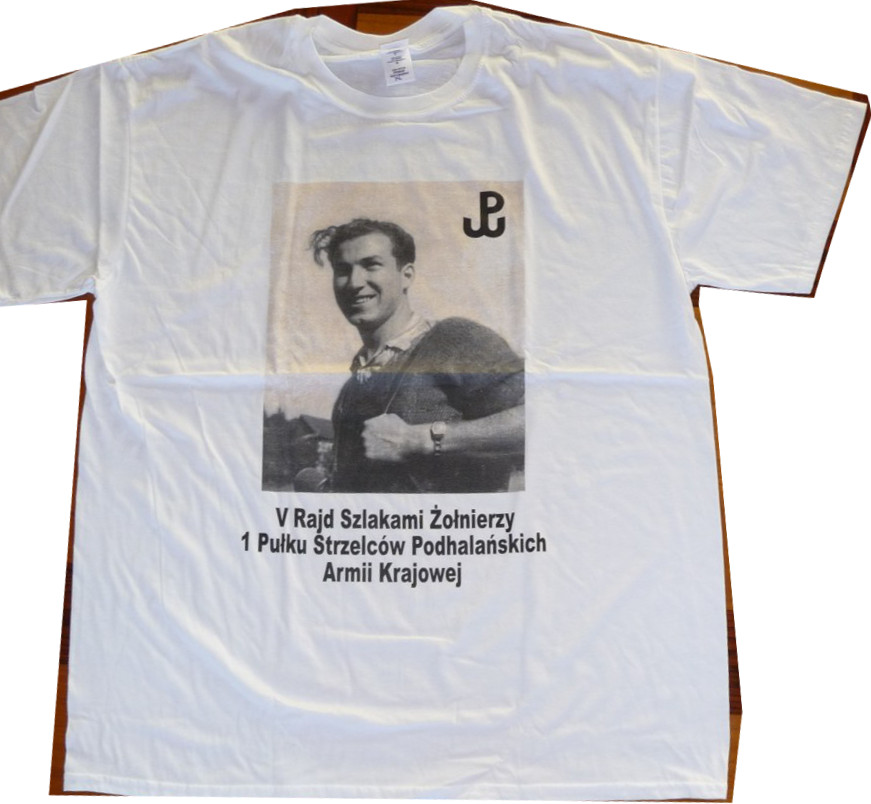
|
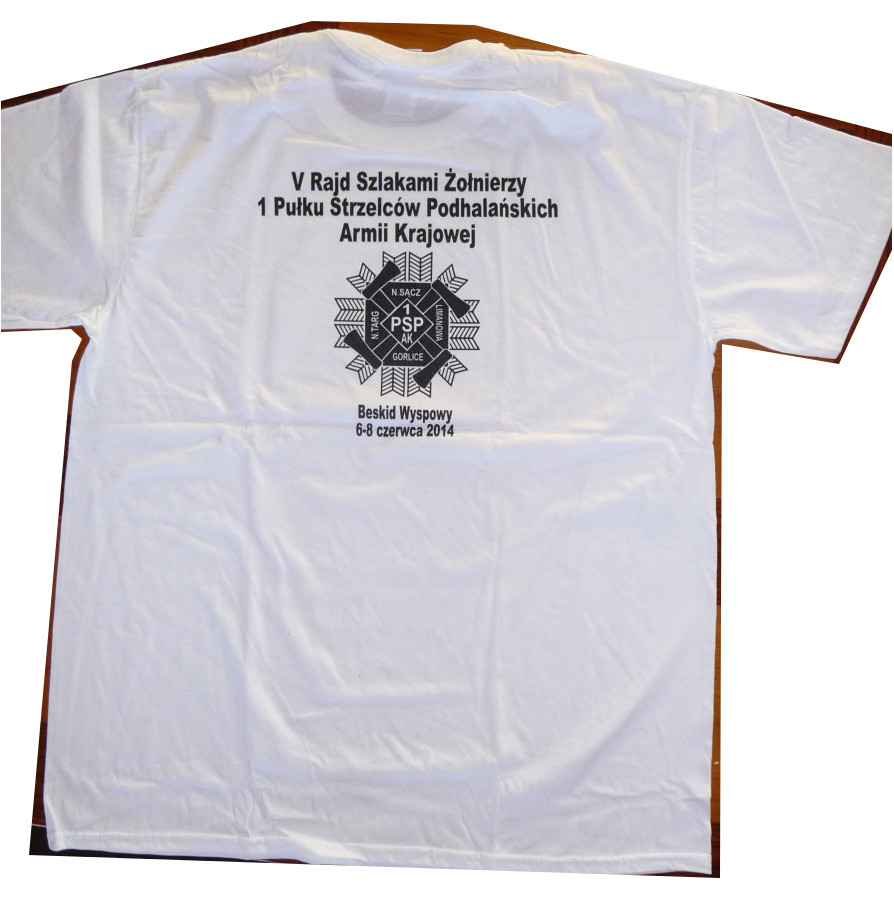
|
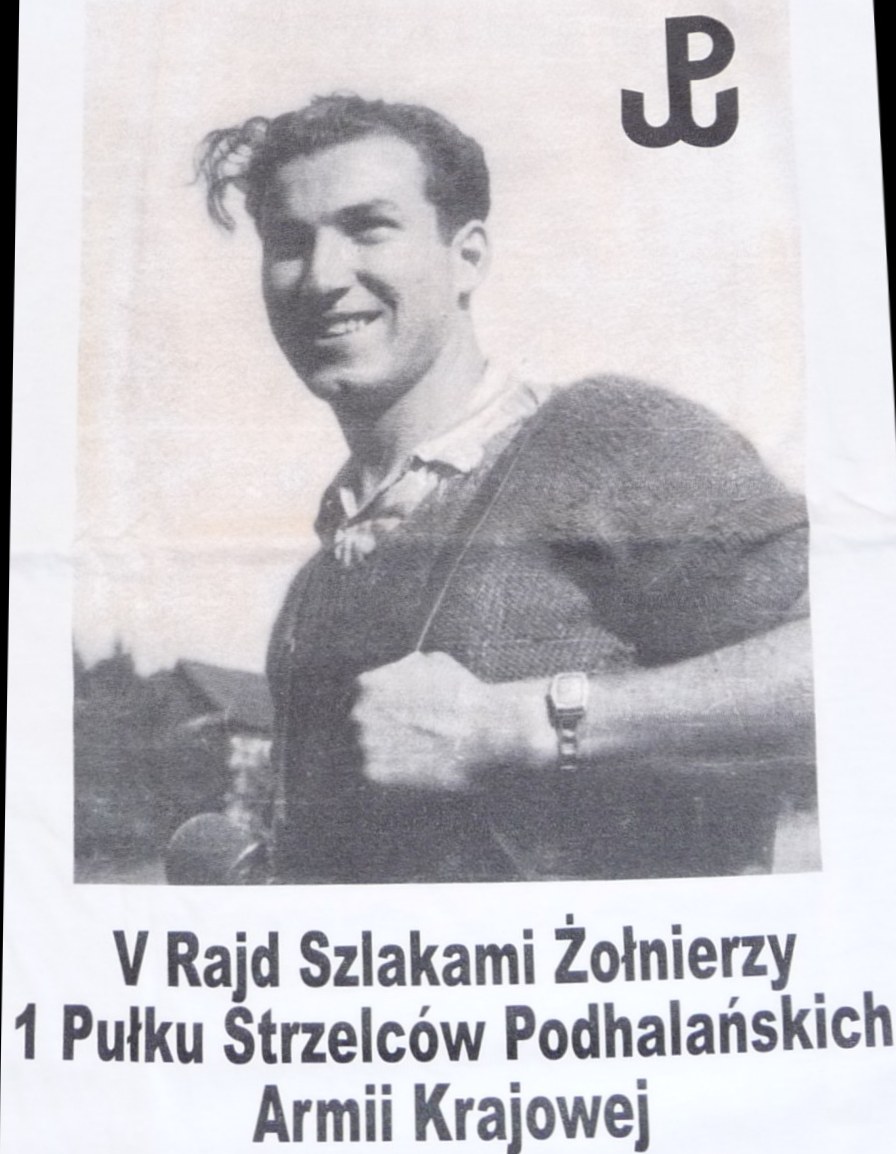
|

On Thursday, November 12, 2015, the town of Tymbark in southern Poland opened a 16 kilometers long
tourist-educational historical trail remembering/ commemorating the Polish Home Army ( 1 PSP AK ) clandestine activities in 1939-1945 during the Second World War against the German Nazi occupiers.
(Tymbark is a village of population just over 2,400 in southern Poland, some 60 km south-east of Kraków, and 8 kilometres west of Limanowa. )
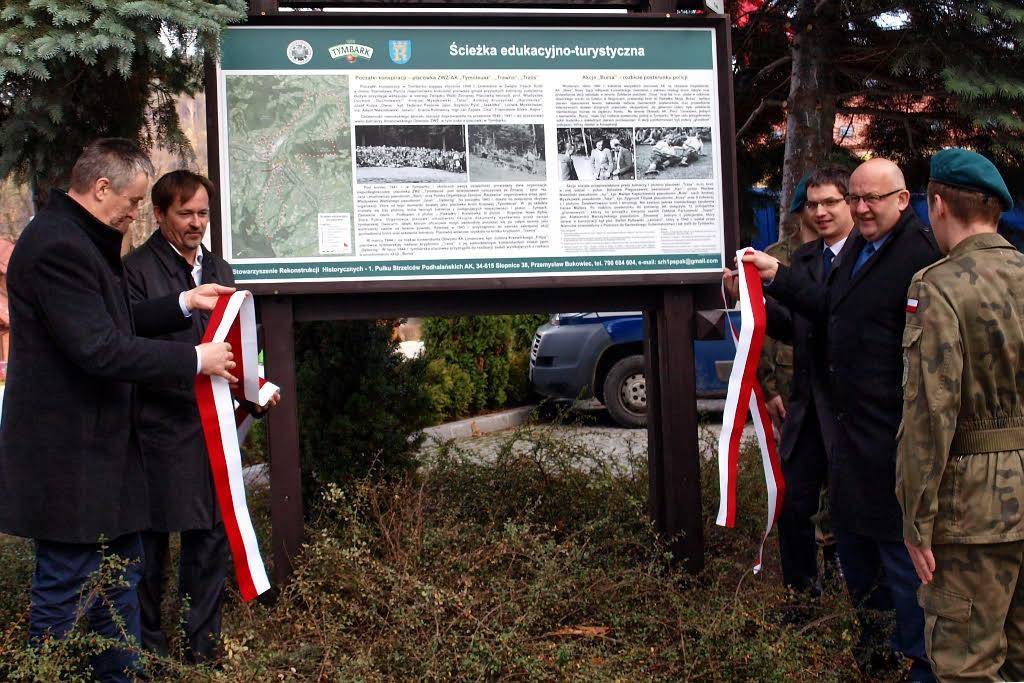
|

|

|

|
There is a stone Obelisk monument, information boards and photos on this trail that reference and remember Hubert Brooks.
The 16 kilometer long trail leads to several historic sites related to the period of German occupation, for example "Owocarnia" and family mansion Myszkwoskich and Turskichhas. The trail has six information boards erected along its route containing materials, photographs and eyewitness accounts from the period of the German Nazi occupation.
The trail starts and ends in the town of Tymbark and goes between the mountain massifs Lopienia, Zezowa and Paproci and runs along asphalt roads, dirt roads and partly along hiking trails .
The main aim of the trail is to educate the younger generation and also the inhabitants of Tymbark and the surrounding area wanted to commemorate the hardships involved by the German army of occupation.


The stone Obelisk commemerating Hubert Brooks, is seen in the middle of the photo immediately to the right - between the soldiers.
There are 2 plaques on the stone Obelisk. The one on the left is for Hubert Brooks and John Duncan. An enlarged image of this plaque remembering Hubert Brooks can be seen in the photo on the far right.
The plaque loosely translated from Polish reads:
******************************************************
Dzielcu Allied Pilots Obelisk
In the second half of 1944 in the area of the Mogielica command of 1 PSP AK, brought together allied pilots , rescued from the downed planes bound to help the Warsaw home government.
Among the survivors pilots were from United States of America - Great Britain- Canada - Republic of South Africa.
In a very special way their fighting in the Carpathians and the Gorce have earned special mention:
Canadian - RAF pilot Lt. AK Hubert Brooks ps. "Jubelt"
Scot sergeant - John Duncan ps. "John"
Honor to their memory!
******************************************************
The other plaque on the bottom right of the stone Obelisk loosely translated from Polish says:
Dropzone on Dzielcu "Sojka" 401
The knives of 9/10 July 1944. In the clearings dividing the forest occurred the dropping of weapons, uniforms and supplies by the crew of a British plane Handley Page Halifax JP-254 "D" pilot W/ O Clacketta, to the soldiers AK
and
The last flight of the Halifax
On the night of 3/4 July 1944, the British airplane piloted by W/O Charles Thomas Fairweather en route to the facility Drop on Dzielcu at Mogielica, was shot down over Yugoslavia.
The entire crew was killed, soldiers aged 20-24.
They rest on the British war cemetery in Belgrade.
Honor to their memory!
******************************************************
Tymbark Trail Dzielcu Zapraszamy Information Board Referencing Hubert Brooks


Immediately adjacent to the stone Obelisk discussed above, there is an Information Board (Zapraszamy) which describes in further detail the reason for the stone Obelisk and again referencing Hubert Brooks and John Duncan.
The Polish text starting at the 2nd paragraph reads as follows:
******************************************************
OBELISK LOTNIKÓW ALIANCKICH
Staraniem członków Stowarzyszenia Rekonstrukcji Historycznych 1. Pułku Strzelców Podhalańskich AK ze Słopnic upamiętniono lotników alianckich,
którzy
wypełniając swój żołnierski obowiązek, nieśli pomoc dla walczącej Warszawy,
dokonywali zrzutów dla AK i niszczyli w nalotach niemiecką infrastrukturę wojenną na terenie Polski. Na granitowej tablicy zamontowanego na Dzielcu obelisku, zostały wymienione kraje,
z których pochodzili lotnicy.
W szczególny sposób upamiętniono dwóch obcokrajowców walczących w szeregach AK:
* Kanadyjczyka, pilota R.C.A.F, ppor. AK " Huberta Brooksa „Jubelta"
* Szkota, sierżanta piechoty " Johna Duncana „Johna"
którzy po ucieczce z niemieckich obozów jenieckich, służyli w oddziałach partyzanckich Armii Krajowej, na obszarze Beskidu Wyspowego i Gorców w latach 1943-1945.
Na drugiej tablicy został upamiętniony zrzut na Dzielcu dokonany przez załogę samolotu Handley Page Halifax JP-254 „D- pilota W/O Clacketta, dla żołnierzy Armii Krajowej w nocy z 9/10 lipca 1944r.
Upamiętniono również lotników z załogi brytyjskiego bombowca pilotowanego przez W/O Charlesa T. Fairweathera, zestrzelonego nad Jugosławią w nocy z 3/4 lipca 1944r., w drodze na
placówkę
zrzutową na
Dzielcu k. Mogielicy.
Poległa cała załoga, żołnierze w wieku 20-24 lat. Spoczywają na brytyjskim cmentarzu wojennym w Belgradzie.
******************************************************
Which loosely translated into English says:
Obelisk For Allied Airmen
Through the efforts of members of the Association of Living History 1. Highland AK Rifle Regiment commemorated with Slopnice Allied airmen who fill their soldierly duty, carrying aid for fighting Warsaw,
discharges for AK and destroyed in the air raids the German military infrastructure on Polish territory.
On a granite plate mounted on Dzielcu obelisk, they listed the countries from which they came airmen.
In a special way we commemorated the two foreigners who fought in the ranks of the AK:
* Canadian pilot R.C.A.F, Lt. AK - Hubert Brooks "Jubelt "
* Scotish, infantry sergeant - John Duncan "John"
who after their escape from German POW camps, served in the guerrilla Home Army , in the area of the Carpathians and the Gorce in 1943-1945.
**********
The second plaque on the stone Obelisk is marked dump on Dzielcu made by the crew of the aircraft Handley Page Halifax JP-254 "D" pilot / O Clacketta for Army soldiers on the night of 9/10 July 1944.******************************************************
Tymbark Trail Zrzutowisko - Dzielcu - Sojka nr 401 Information Board Referencing Hubert Brooks
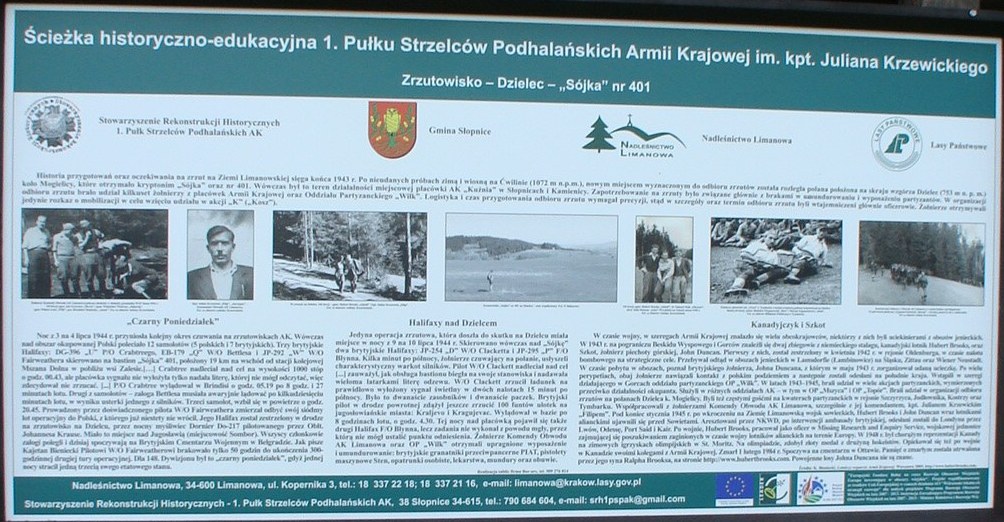
The other information board summarizing the exploits of Julian Krzewicki which also contains a reference to Hubert Brooks and John Duncan is shown in the image at the right.
As can be seen, there are 3 topics discussed on this board with the one concerning Hubert Brooks the paragraph on the far right of the board labelled " KANADYJCZYK I SZKOT".
The Polish and English translated text from the INformation Board appears below.
Note also that at least 2 of the pictures on this Information Board - the 3rd and 5th photos from the left ( also shown elsewhere on this web site) - show Hubert Brooks.
******************************************************
KANADYJCZYK I SZKOT
W czasie wojny, w szeregach Armii Krajowej znalazlo sie wielu obcokrajowców, sposród których wielu bylo uciekinierami z obozów jenieckich.
W 1943 r. na pograniczu Beskidu Wyspowego i Gorców znalezli sie dwaj zbiegowie z niemieckiego stalagu, kanadyjski lotnik Hubert Brooks, oraz Szkot, zolnierz piechoty górskiej, John Duncan.
Pierwszy z nich, zostal zestrzelony w kwietniu 1942 r. w rejonie Oldenburga, w czasie nalotu bombowego na strategiczne cele. Przebywal odtad w obozach jenieckich w Lamsdorfie (Lambinowice) na Slasku, Zittau oraz Wiener Neustadt.
W czasie pobytu w obozach, poznal brytyjskiego zolnierza, Johna Duncana, z którym w maju 1943 r.
zorganizowal udana ucieczke. Po wielu perypetiach, obaj zolnierze nawiazali kontakt z polskim podziemiem a nastepnie zostali odeslani na poludnie kraju. Wstapili w szeregi dzialajacego w Gorcach oddzialu partyzanckiego OP „Wilk".
W latach 1943-1945, brali udzial w wielu akcjach partyzanckich, wymierzonych przeciwko dzialalnosci okupanta. Sluzyli w róznych oddzialach AK " w tym w OP „Mszyca" i OP „Topór". Brali udzial w organizacji odbioru zrzutów na
polanach Dzielca k. Mogielicy. Byli tez czestymi goscmi na kwaterach partyzanckich w rejonie Szczyrzyca, Jodlownika, Kostrzy oraz Tymbarku. Wspólpracowali z zolnierzami Komendy Obwodu AK Limanowa, szczególnie z
jej komendantem, kpt. Julianem Krzewickim „Filipem".
Pod koniec stycznia 1945 r. po wkroczeniu na Ziemie Limanowska wojsk sowieckich, Hubert Brooks i John Duncan wraz lotnikami alianckimi ujawnili sie przed Sowietami. Aresztowani przez NKWD, po interwencji ambasady brytyjskiej,
odeslani zostali do Londynu przez Lwów, Odesse, Port Said i Kair.
Po wojnie, Hubert Brooks, pracowal jako oficer w Missing Research and Enquiry Service, wojskowej jednostce zajmujacej sie poszukiwaniem zaginionych w czasie wojny lotników alianckich na terenie Europy.
W 1948 r. byl chorazym reprezentacji Kanady na zimowych igrzyskach olimpijskich w St. Moritz. Na olimpiadzie, zdobyl zloty medal z druzyna hokeistów.
Opiekowal sie tez po wojnie w Kanadzie swoimi kolegami z Armii Krajowej.
Zmarl 1 lutego 1984 r. Spoczywa na cmentarzu w Ottawie.
Pamiec o zmarlym zostala utrwalona przez jego syna Ralpha Brooksa, na stronie http://www.hubertbrooks.com.
Powojenne losy Johna Duncana nie sa znane.
******************************************************
Which loosely translated into English says:
CANADIAN AND A SCOT
During the war, in the ranks of the Home Army were many foreigners, many of whom were refugees from POW camps.
In 1943, on the border between the Carpathians and the Gorce they were two fugitives from a German Stalag; Canadian aviator Hubert Brooks, and the Scot, mountain infantry soldier, John Duncan.
The first of them was shot down in April 1942 in the area of Oldenburg, during a bombing raid on strategic objectives. He was henceforth in POW camps in Lamsdorfie (Lambinowice) in Silesia, Zittau and Wiener Neustadt. During his stay in the camps, he met British soldier, John Duncan, with whom in May 1943 held a successful joint escape.
After many vicissitudes, the two men made contact with the Polish underground and then were sent to the south of the country. They joined the ranks of acting Gorce partisan unit OP "Wilk".
In the years 1943-1945, they participated in many guerrilla operations campaigns directed against the occupier. They served in different branches of the AK - including OP "Mszyca" and OP "Topór". They took part in the organization receiving discharges in clearings dividing k. Mogielica. They were also frequent guests by those providing accommodation to the guerrillas in the area Szczyrzyc, Jodlownik, Kostrza and Tymbark. They collaborated with the soldiers of the AK District Headquarters Limanowa, especially with its commander, Capt. Julian Krzewickim "Filip".
At the end of January 1945, after the arrival in Limanowska of Soviet troops, Hubert Brooks and John Duncan with other POW Allied airmen made themselves known to the Soviets. They were arrested by the NKVD. After the intervention of the British Embassy, they were sent back to London by Lviv, Odessa, Port Said and Cairo.
After the war, Hubert Brooks worked as an officer in Missing Research and Enquiry Service, the military unit involved in the search for missing Allied airmen during the war in Europe.
In 1948 he was the flag standard-bearer representing Canada at the Winter Olympics in St. Moritz. At the Olympics, he was part of the team that won a gold medal for hockey.
He took care of colleagues from the Home Army after the war in Canada.
He died on February 1, 1984. Buried in a cemetery in Ottawa.
The memory of the deceased was preserved by his son Ralf Brooks on page http://www.hubertbrooks.com.
John Duncan's postwar fate is unknown.
******************************************************
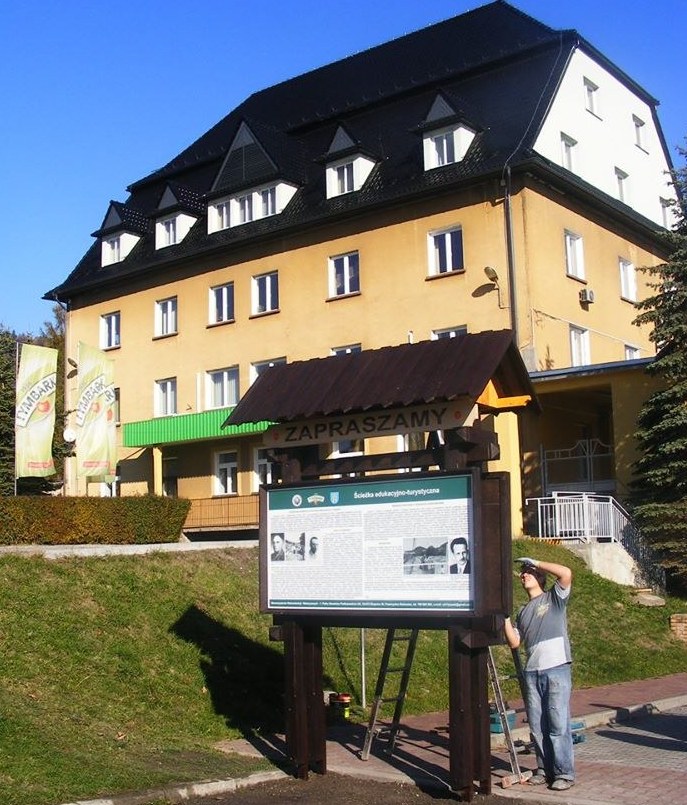
|
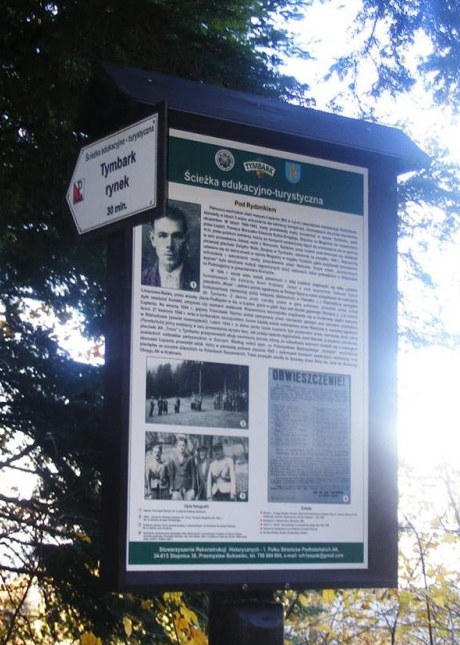
|

|
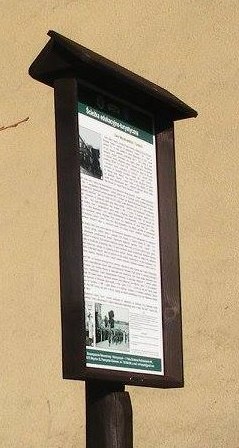
|

|
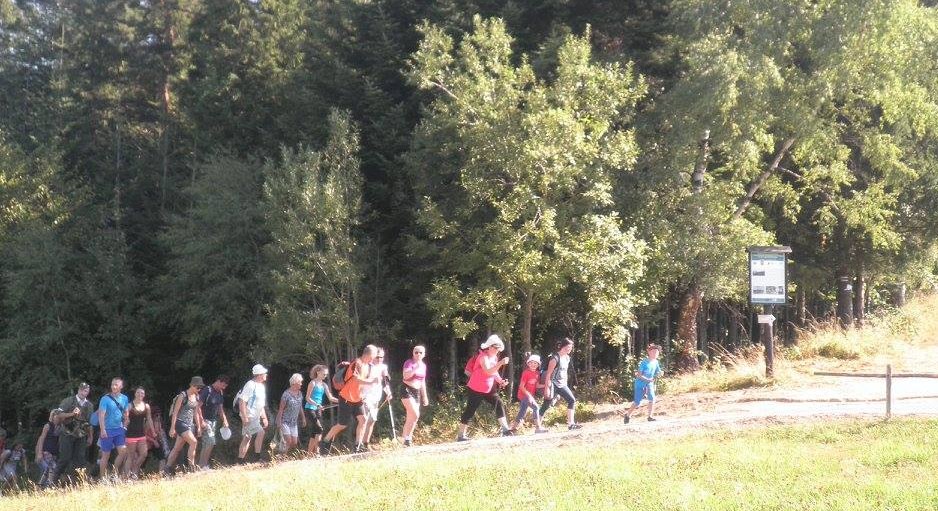
|

Late 1945 the Soviet's kept their oppression ever present even after the end of war hostilities.
To the profound annoyance of the British government, the Soviet friendly
Polish Government refused to allow British Military search teams to enter Poland to round up remaining British missing airmen and former prisoners of war.
This refusal was widely thought
to be dictated by the Soviet authorities desire that the British not have the on-site means of determining information regarding dispersal of their forces in Poland.
This was in contrast to the full co-operation of other former enemy-oocupied Allied countries e.g. Czechoslovakia, Holland, Belgiun and France.
******************************************************
Sadly, those that got out were the fortunate ones. Many others remained behind in Poland. They were accustomed all of them by history to the invaders heel. I'm glad that for a while I fought beside them, and was able to help them in their cause.
But our victories in the Polish A.K. were costly at times. Invariably, German sadism and vengeance
were wreaked upon the local civilian population.
There was not merely one Polish Lidice. The towns of Wiśniowa and
Lipnik, for example, were burned to the ground, and many peasants were burned alive.
The entire village of Porąbka was wiped from the face of the earth, twenty–five of the villagers being locked in a
barn and cremated alive; several children, two or three years old, were bayoneted and tossed into the flames.
But why do I single out these instances? They are merely typical of what happened all over Poland.
Of all the countries involved in the war, Poland lost the highest percentage of its citizens: over six million perished,
half of them Polish Jews.
(Editor's Note: See for example web account
The Devil's Playground: Poland in World War II by Piotr Wrobel.)
Yet in spite of such terrorism, we still received every assistance and cooperation; precise information
regarding the Germans' movements was cheerfully supplied.
Finally, the Huns became so apprehensive that they did not dare to appear on the streets at night.
After 10PM, the night belonged to us.
It is my firm belief that the A. K. was the strongest and most efficient organization of its kind in the whole of Europe. The A.K. Home Army had an estimated 350,000 soldiers under oath during World War II. As a member of the A. K., I received a cordial welcome from all of the Polish people, regardless of class; the same friendliness from peasants as from members of the intelligentsia. Polish hospitality was unbounded. Let a Pole learn that you were American, Canadian or British, and he would give you the very shirt from his back.
******************************************************
Several years later I was asked to write a brief one page summary of the operation of the Polish Underground Organization
during World War II.
The following AIDE MEMOIRE dated 23–Oct–70 on the POLISH UNDERGROUND ORGANIZATION is reproduced here.
POLISH UNDERGROUND ORGANIZATION
Hubert Brooks died on February 1, 1984 of a sudden heart attack. He was 62 years old.
What follows are some comments from some of his AK friends....
On hearing of Hubert Brooks' death in 1984 ..... The message about so untimely death of Hubert felt like a
bombshell. I met Hubert at the foothills of the Carpathians in Southern Poland in November 1943. Soon he captivated hearts of everyone who
met him because of his highest qualities as a soldier and as a man. Hubert became the most popular partisan in the Polish Highland. And
I believe that nobody can be more modest and humble than Hubert was. I'm proud to say that we became friends and I will always cherish
the memory of that friendship.
Adam Stabrawa (ps "Borowy") Dec 20, 1984
On hearing of Hubert Brooks' death in 1984 ...... This was a shocking experience for me because Hubert was
my closest friend. Our friendship started when he was in Poland and stayed for some time in my family's house. I shall inform Hubert's friends
in Poland- where he was remembered and considered as a Polish hero. Let's hope that his homeland Canada will feel the same .....
Abbot Hubert Kostrzanski (ps "Mirt") July 6, 1984
"Throughout the time he served as an officer with the Polish Home Army he showed great courage and
outstanding ability as a leader. Brooks took part in many ambushes and attacks on the Germans. Brooks was responsible for selecting suitable
landing grounds in the Nowy Sacz, Myslenice and Bochnia areas for aircraft sent from Italy to Poland. He was also responsible for the
security and welfare of 17 British and American soldiers and airmen who were under the protection of the Polish Home Army"
(Polish) F/O W. Schoffer (ps "Samborski"), RAF
| PREVIOUS PAGE | GO TO TOP OF PAGE FOR INTER- and INTRA- CHAPTER NAVIGATION MENUS |
NEXT PAGE |
The Life and Times of Hubert Brooks M.C. C.D.